
Modern smartphones are equipped with GPS capabilities that make navigation easier than ever. But when you're heading into the wilderness without reliable access to a charger, adding a compass to your hiking backpack can be a lifesaving choice.
Even if you only wind up carrying it as a backup, it's better to have one and not need it than face the consequences of being lost on the trail. Learning to use a compass is a critical survival skill, but you can't practice unless you have the right compass.
Luckily, you're in the right place to explore a collection of the best compass models on the market. Whether you have hiking shoes on your feet, hiking boots up to your ankles, or you’re in the cockpit of a kayak, the best compasses will help you stay on course. Let's navigate our way through them!
Why Trust Us?
ACTIVE.com's editorial team relies on the knowledge and experience of fitness and wellness experts including competitive athletes, coaches, physical therapists, nutritionists, and certified trainers. This helps us ensure that the products we feature are of the highest standard. Collectively, the team has spent countless hours researching equipment, gear, and recovery tools to create the most accurate, authentic content for our readers. Customer satisfaction is a key part of our review process, which is why we only feature products that are highly rated. More importantly, each member of our team is a fitness enthusiast. Fitness may be our job, but it is also our passion. Therefore, we strive to bring you products that we trust and would personally use.
The Best Compasses - Our Top Picks
By clicking on the product links in this article, we may receive a commission fee at no cost to you, the reader. Sponsorships and affiliate commissions help support our research so we can help you find the best products. Read our full affiliate disclosure here.
- Best Compass Overall: Suunto MC-2G Navigator Compass
- Best Compass for Hiking: TruArc 10 Compass
- Best Compass for Kids: TurnOnSport Orienteering Compass
- Best Compass for Land Navigation: Suunto MC-2 Pro Compass
- Best Budget Compass: Suunto A-10 Compass
- Most Durable Compass: Cammenga Official US Military Tritium Lensatic Compass
- Best Compact Compass: M-9 Wrist Compass
Best Overall - Suunto MC-2G Navigator Compass
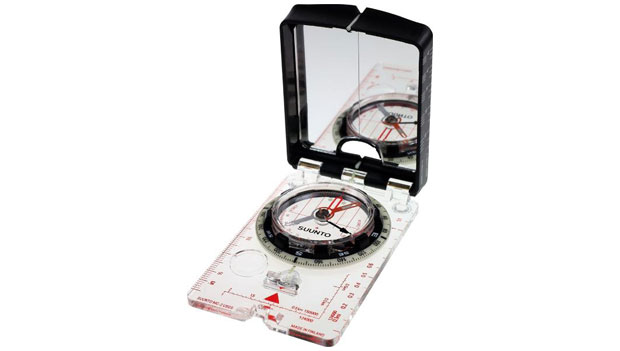
SPECS
- Dimensions: 3.9" x 2.5"
- Weight: 2.6 oz.
- Type: Baseplate compass
Suunto's MC-2G Navigator Compass is ideal for global travelers. It's equipped with a global needle, declination adjustment, a sighting mirror, and a clinometer. The baseplate also includes a ruler and magnifying lens that make it easier to plot accurate map readings.
This compass comes with a lanyard that includes the key you'll need to adjust its declination scale. You can wear it around your neck for easy access or attach it to your bag for safekeeping. This compass’ needle and magnet function independently, which prevents magnetic field inclination from tilting the needle.
What We Like
- Adjustable declination scale to account for differences between true north and magnetic north
- Easy-grip bezel with two-degree increments
- Luminous outer ring for reading in dim conditions
What We Don't Like
- You can easily find a cheaper compass
- Accuracy outside of limited latitudes can be flawed
BUY: Suunto MC-2G Navigator Compass
Best Compass for Hiking - TruArc 10 Compass

SPECS
- Dimensions: 5.2" x 2.8" x 0.5"
- Housing material: Plastic
- Weight: 1.7 oz.
- Type: Baseplate compass
The TruArc compass is a great choice for hiking because it can be used on the move. It doesn't need to be perfectly level with the ground to provide accurate readings, and the global needle prevents it from sticking at equatorial latitudes or in the southern hemisphere.
The compass baseplate is manufactured with durable, double-gauge plastic, so you won’t need to worry about damaging it on your adventures. Its easy-to-use interface is a top choice among professional guides, adventure racers, and orienteering enthusiasts, alike.
What We Like
- Ever-North magnet
- Adjustable declination
- Magnified readout with reversible scale
What We Don't Like
- No way to secure it to your belt or backpack
- No capability to sight distant objects
BUY: TruArc 10 Compass
Best Compass for Kids - TurnOnSport Orienteering Compass
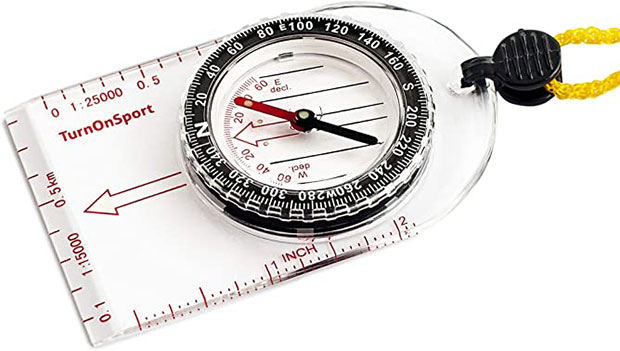
SPECS
- Dimensions: 4.5" x 2"
- Material: Acrylic
- Weight: 1.7 oz.
- Type: Baseplate compass
This compass is a great, cheap option for kids learning how to orient and navigate in the wilderness. It makes a wonderful gift for those joining youth organizations that focus on outdoor education and wilderness survival skills.
Its lightweight and strong acrylic design features a rotating bezel, a baseplate with azimuth bearing, and a magnetic needle. This compass also boasts a two-inch ruler and a direction arrow to remind kids how to orient the compass when taking a bearing.
What We Like
- Super affordable
- Easy to use
- Includes security lanyard
What We Don't Like
- No advanced features
- May not be the most accurate
BUY: TurnOnSport Orienteering Compass
Best Compass for Land Navigation - Suunto MC-2 Pro Compass
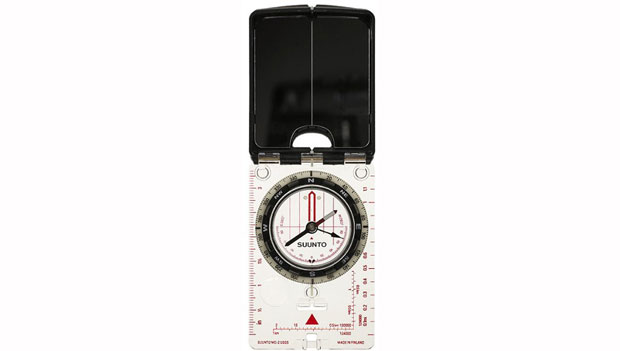
SPECS
- Dimensions: 3.9" x 2.5" x 0.6"
- Weight: 2.65 oz.
- Type: Baseplate compass
A close second to our choice for the best overall compass, the Suunto MC-2 is a slightly more affordable option with many of the same features, including declination adjustment and a sighting mirror.
The V-notch in the sighting mirror allows serious users to easily sight objects in the distance while reading the compass bearing. The mirror also folds down to protect the compass between uses.
What We Like
- Balanced for use in the northern hemisphere
- Meridian lines on baseplate help with orientation
- Features a clinometer to measure slope angles
What We Don't Like
- Heavier
- Less durable than other Suunto compasses
Best Budget Compass - Suunto A-10 Compass
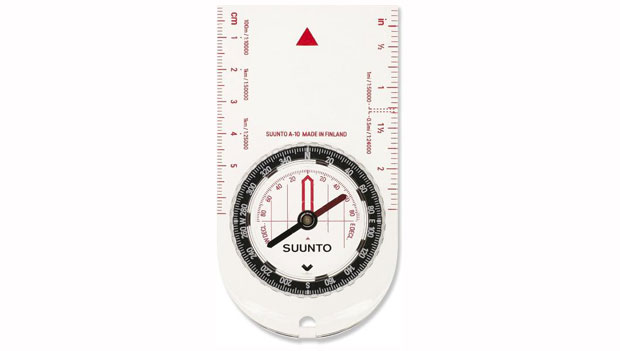
SPECS
- Dimensions: 4.09" x 2.2" x 0.39"
- Weight: 1.06 oz.
- Type: Baseplate compass
The A-10 is arguably Suunto's most affordable compass, but it does not skimp on features. It boasts a declination scale, a ruler, and a high-grade steel needle. It also features a liquid-filled capsule that stabilizes it during operation.
What We Like
- The price is right
- Detachable lanyard
- Lightweight
What We Don't Like
- No declination adjustment
- No clinometer
BUY: Suunto A-10 Compass
Most Durable Compass - Cammenga Official US Military Tritium Lensatic Compass
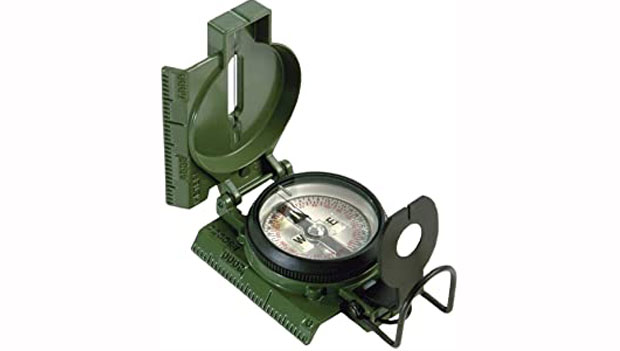
SPECS
- Dimensions: 6" x 4" x 3"
- Material: Powder-coated aluminum
- Weight: 8.8 oz.
- Type: Lensatic compass
Trusted by professionals who need to navigate in life-and-death situations, the Cammenga compass offers superior navigation for outdoor enthusiasts. It excels for hiking, backpacking, hunting, boating, orienteering, and a variety of other outdoor uses.
It's entirely waterproof and features a self-powered light that lasts up to 12 years. And it includes a magnifying lens, sight wire, and dial graduations in millimeters and degrees for more accurate readings.
What We Like
- Heavy-duty design for serious outdoor enthusiasts
- Performs well in extreme temperatures
- Official US Military compass
What We Don't Like
- Heavy
- Requires more advanced orienteering skills
BUY: Cammenga Official US Military Tritium Lensatic Compass
Best Compact Compass - Suunto M-9 Wrist Compass

SPECS
- Dimensions: 1.61" x 1.85" x 0.55
- Weight: 0.6 oz.
- Type: Thumb/wrist compass
Ideal for adventure racers or anyone that needs to navigate on the go, this wearable compass is lighter than most wrist watches. But don’t let its weight fool you. It still offers heavyweight features like a serrated bezel ring that makes it quick and straightforward to orient.
The compass is backlit for easy reading in dim conditions, and you can attach it to your wrist with the removable Velcro band. From ultralight hiking to sailing races, a wrist compass like this is as versatile as it is dependable.
What We Like
- Compact
- Lightweight
- Wearable
What We Don't Like
- No sighting mirror
- No declination scale or adjustment
How to Choose a Compass
Before you begin your search, consider which kinds of compasses you’ve used before. The more familiar you are with a certain type of compass, the easier it will be to use. Below, you’ll find some other important factors to consider.
Types of Compasses
There are many compasses for hiking, backpacking, orienteering, and other outdoor pursuits.
Here's the full list and some of their best uses:
- Baseplate: The most common and affordable. Good for plotting map locations, but cannot accurately sight distant objects.
- Card (aka Marine): Uses a fixed needle and requires movement of the card to get directional readings. Often used on boats because the card absorbs motion, making it easier to read than a needle compass.
- Thumb (and Wrist): Often used by competitors in orienteering sports because of the ease of multitasking. You can hold this compass (and a map) in one hand while running, biking, etc.
- Lensatic: Features a three-part design: base, lens, and cover. Often used by the US military.
- Prismatic: Highly accurate. Allows you to sight distant objects while simultaneously reading the compass bearings.
- Gyro: Commonly used by large seafaring vessels because they're unaffected by external magnetic fields.
- Electronic: Stores bearings easily but requires a power source and is not ideal for map work.
Features
Here are the four features that are most important in a high-quality compass:
- A global needle. Compasses without one will only work in the northern hemisphere. If you travel globally or south of the equator, a global needle is essential.
- A clinometer. Helps you measure slope, height, and distance. Essential for backcountry skiers and mountaineers to assess avalanche hazards and other environmental risks.
- A sighting mirror. Great for off-trail exploration or those seeking more precise navigation. These make it easier to sight the object you're taking a bearing on while also viewing your compass housing.
- Declination adjustment. Declination is the difference between magnetic north and true north. The angle of declination varies based on location and changes over time, so a compass with declination adjustment is vital for getting an accurate heading.
Dimensions
Another factor to consider is the size of the compass. If you're going to be using it on extended backpacking trips, for example, you're going to want something compact and lightweight.
But if you need a compass for kayaking or sailing, you'll likely have a little more space for a larger compass with additional features. And if you're only getting a compass to practice your orienteering skills on day trips, size isn't as important as other features.
FAQs About Compasses
To further aid your selection process, here are answers to frequently asked questions about the best compasses.
How much does a compass cost?
Good compasses can cost anywhere from as little as $10 to more than $100. When you're looking for a high-quality compass with features like a clinometer, global needle, and declination adjustment, expect to spend more than $100.
What type of compass does the military use?
Lensatic compasses are the most common type for military use. These compasses offer a heavy-duty design with three distinct parts (base, lens, and cover) that make them durable and accurate.
Do I need a compass for hiking?
It’s always a smart move to keep a compass in your pack. Compasses are more commonly used for off-trail hiking and wilderness orienteering than they are for hiking on established, well-marked trails.
Are cheap compasses accurate?
More expensive compasses tend to be more accurate than cheaper ones, but it is more important that you know how to maximize your compass' features. Suunto is one of the leading compass brands out there right now, and they offer several models at varying price points.

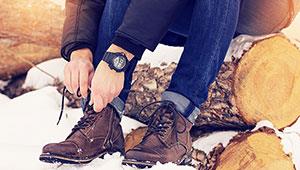
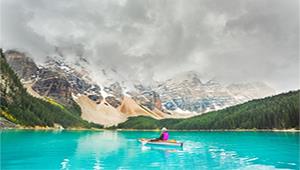


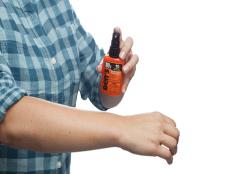


Discuss This Article